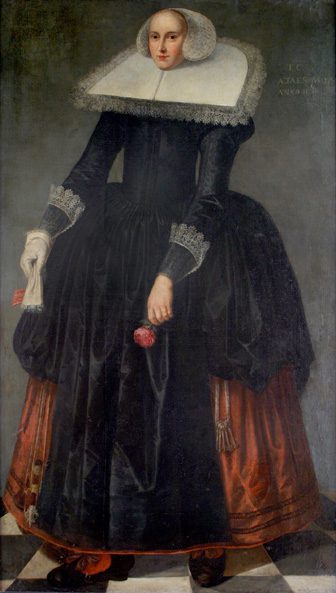Orit Pinhas-Hamiel
Hamiel Uri
Tirosh Amit
Ramat Gan, Israel
 |
| A life-size painting of Trijntje Keever. Unknown Painter. 1633. Via Wikimedia. |
There is a life-size painting in the city of Edam in The Netherlands that portrays a girl who is exceptionally tall with disproportionately long hands. The artist is unknown, but the name of the girl in the picture is Trijntje Keever.
Trijntje was born in April 1616, the daughter of Cornelis Keever, a Dutch skipper from the Prussian city of Elbing (now Elblag in Poland), and Anna Pouwels Cornelis, who was his maid. Trijntje had two half-siblings from her father’s previous marriage. When Trijntje was nine years old, she was already two meters (six feet, seven inches) in height and her parents earned money by charging people at fairs to see their very tall daughter. Trijntje lived a short life, dying of cancer at the age of seventeen. She was buried on July 7, 1633, in her hometown of Edam, and the epitaph on her tombstone remembered her as a “big girl.”
Years ago, I had attended a lecture by Professor Márta Korbonits, who with permission from the Hunterian Museum in England had extracted a sample of DNA from the skeleton of Charles Byrne, a man who had died in the eighteenth century, and diagnosed a genetic mutation. I had also read that the original shoes of Trijntje Keever were on display at Edam Museum. Would it be possible to collect a DNA sample from the shoe and decipher the cause of her tall stature? I wrote an email to the museum to find out.
While I waited for their response, my colleagues and I began to brainstorm plausible diagnoses for Trijntje’s condition. In differentiating tall stature that is benign from tall stature because of an underlying disorder, the distinction is made between normal appearance and dysmorphic appearance.1 The face of Trijntje as depicted in the painting excluded syndromes such as Sotos, Weaver, and Simpson Golabi-Behmel as causes for her tall stature. Furthermore, her height of two meters at the age of nine is taller than would be expected in syndromes such as Marfan, homocystinuria, and Beckwith-Wiedemann. Trijntje’s extremely tall stature suggests chronic excessive production and secretion of growth hormone (GH), which causes accelerated growth.
Acromegaly and gigantism result from excessive GH and represent a continuum of clinical manifestations. They are distinguished by whether the epiphyseal growth plates are fused (acromegaly) or not fused (gigantism) during GH over secretion. Overproduction of GH is virtually always caused by pituitary adenoma, and rarely secondary to increased secretion of GH–releasing hormone (GHRH) by an intracranial or ectopic source (e.g. neuroendocrine tumors of the pancreas and the bronchopulmonary tract). Gigantism can occur as one of many features in inherited conditions such as multiple endocrine neoplasia type 1 (MEN 1), Carney complex, and McCune-Albright syndrome,2-4 or it can be an isolated manifestation of familial isolated pituitary adenoma (FIPA).5
MEN1 and Carney complex are autosomal dominant syndromes characterized by endocrine tumors. The pituitary tumors in MEN-1 are most commonly prolactinomas and acromegaly is seen in only 10% of cases. Similarly, GH-secreting pituitary adenoma or pituitary somatotropic hyperplasia leading to acromegaly occurs in about 10% of the cases in Carney complex. Both syndromes have other prominent characteristics. The lack of family history or a history consisting of other tumors makes these diagnoses unlikely for Trijntje. McCune-Albright syndrome consists of a triad of poly/monostotic fibrous dysplasia, café-au-lait spots, and hyperfunctioning endocrinopathies. Growth hormone hypersecretion affects around 20-30% of patients with McCune-Albright syndrome, yet the mean age at diagnosis of acromegaly is twenty-four. In more than 60% it was diagnosed during adulthood, which makes this syndrome less likely for the case presented.
Considering the age at diagnosis and the absence of other clinical manifestations, the two most probable diagnoses for an early presentation with pituitary gigantism are a germline mutation in the Aryl Hydrocarbon Interacting Protein (AIP) gene, which is inherited as an autosomal dominant trait with very low penetrance (AIP-related FIPA)6 and X-linked acrogigantism (XLAG).7, 8
Because of the incomplete penetrance of AIP-related FIPA, the disease can also manifest as apparently sporadic prolactin-/GH-secreting, or non-functioning pituitary tumor. Thus, the absence of a family history does not counter this diagnosis. Most pituitary adenomas in childhood are macroadenomas, and locally invasive tumors are frequently observed. While the diagnosis of AIP-related FIPA in this vignette is plausible, first symptoms occur predominantly in males (63.5%) and during childhood or adolescence in 50%.
 |
| A photograph of Trijntje Keever’s original shoes. Courtesy of the Edam Museum. Published with Permission. |
X-linked acrogigantism (XLAG) explains the majority of prepubertal cases (80%), manifesting with exceedingly excessive growth. A unifying feature of the XLAG syndrome is the strikingly early age at onset; increased length usually occurs before the age of one year. Most individuals with this syndrome are females, and the syndrome may occur sporadically. XLAG is caused by an Xq26.3 genomic microduplication that is generated during chromosome replication and contains four protein-coding genes. Only one of these genes, GPR101, which encodes a G-protein–coupled receptor, was found duplicated in these pituitary lesions. Interestingly, in published cases, subjects with XLAG had acral enlargement as well as a remarkable increase in foot size, although GH oversecretion occurs before fusion of the epiphyseal plates.
Some children with the condition exhibit wide-set eyes in addition to coarsening of the nose and brow, which differs from adult acromegaly. The diagnosis cannot be made from this painting, as it has been said that Trijntje was depicted as prettier than she actually was in life.
A few days after my email to the museum, I received a reply inviting me to Edam to collect a DNA sample. My heart skipped a beat in excitement, but while planning our flight we received another email with a photo of Trijntje’s shoes and the wooden mold fixed inside the shoe to keep it from collapsing. We would need to consider another strategy.
I began to wonder if it would be possible to get DNA from Trijntje’s bones, and I wrote again asking for permission. I was imagining us traveling to Edam to dig up her grave, when the reply arrived: “There has been a big renovation in the big Church in Edam where Trijntje is supposed to be buried. This was a long time ago and although three different sources were contacted no one knows where the exact grave is . . .”
For now, we do not know the underlying condition that let to Trijntje Keever’s astounding height. She remains immortalized in a painting and at a museum, and her story continues to fascinate us.
References
- Corredor B, Dattani M, Gertosio C, Bozzola M. Tall Stature: A Challenge for Clinicians. Curr Pediatr Rev. 2019; 15(1): 10-21.
- Agarwal SK. The future: genetics advances in MEN1 therapeutic approaches and management strategies. Endocr Relat Cancer. 2017; 24(10): T119-T34.
- Salenave S, Boyce AM, Collins MT, Chanson P. Acromegaly and McCune-Albright syndrome. J Clin Endocrinol Metab. 2014; 99(6): 1955-69.
- Stratakis CA. Carney complex: A familial lentiginosis predisposing to a variety of tumors. Rev Endocr Metab Disord. 2016; 17(3): 367-71.
- Rostomyan L, Daly AF, Petrossians P, Nachev E, Lila AR, Lecoq A-L, et al. Clinical and genetic characterization of pituitary gigantism: an international collaborative study in 208 patients. Endocr Relat Cancer. 2015; 22(5): 745-57.
- Beckers A, Aaltonen LA, Daly AF, Karhu A. Familial isolated pituitary adenomas (FIPA) and the pituitary adenoma predisposition due to mutations in the aryl hydrocarbon receptor interacting protein (AIP) gene. Endocr Rev. 2013; 34(2): 239-77.
- Beckers A, Lodish MB, Trivellin G, Rostomyan L, Lee M, Faucz FR, et al. X-linked acrogigantism syndrome: clinical profile and therapeutic responses. Endocr Relat Cancer. 2015; 22(3): 353-67.
- Daly AF, Tichomirowa MA, Petrossians P, Heliovaara E, Jaffrain-Rea ML, Barlier A, et al. Clinical characteristics and therapeutic responses in patients with germ-line AIP mutations and pituitary adenomas: an international collaborative study. J Clin Endocrinol Metab. 2010; 95(11): E373-83.
ORIT PINHAS-HAMIEL, MD, is a full Professor of Pediatrics at the Sackler School of Medicine, Tel-Aviv University. She heads the Pediatric Endocrine and Diabetes Unit at the Edmond and Lily Safra Children’s Hospital, Sheba Medical Center, and the National Juvenile Diabetes Clinic in Maccabi Health Care services. Her research interests are within the fields of obesity-associated comorbidities, specifically type 2 diabetes mellitus in children and adolescents, as well as in type 1 diabetes and eating disorders. She also likes to look at pictures and try to diagnose the depicted subjects.
HAMIEL URI, School of Medicine, Tel-Aviv University, Genetics Institute and Genomics Center, Tel Aviv Sourasky Medical Center, Tel Aviv, Israel.
TIROSH AMIT, Sackler School of Medicine, Tel-Aviv University, Division of Endocrinology, Diabetes and Metabolism, Sheba Medical Center, Tel-Hashomer, Israel.
Acknowledgment: The authors would like to thank Steven Reilingh of the Edam Museum for permission to publish Figure 2.

Leave a Reply